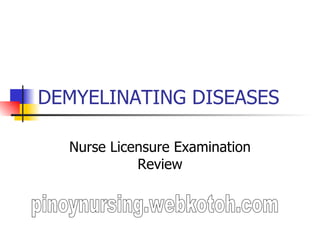Neurology Part 2
•
13 gefällt mir•1,502 views
pinoynursing.webkotoh.com
Melden
Teilen
Melden
Teilen

Weitere ähnliche Inhalte
Was ist angesagt?
Was ist angesagt? (20)
SIXTH CRANIAL NERVE PALSY- Diagnosis and management

SIXTH CRANIAL NERVE PALSY- Diagnosis and management
Andere mochten auch
Andere mochten auch (13)
Ähnlich wie Neurology Part 2
Ähnlich wie Neurology Part 2 (20)
D1- Belly's palsy & Parkinsons Dse presentation.pdf

D1- Belly's palsy & Parkinsons Dse presentation.pdf
Dr Nivedita Bajaj - Basic Facts About Childhood Epilepsy

Dr Nivedita Bajaj - Basic Facts About Childhood Epilepsy
Approach to evaluation of a child with upper motor neuron disorder

Approach to evaluation of a child with upper motor neuron disorder
Mehr von pinoy nurze
Mehr von pinoy nurze (14)
Kürzlich hochgeladen
Kürzlich hochgeladen (20)
"Subclassing and Composition – A Pythonic Tour of Trade-Offs", Hynek Schlawack

"Subclassing and Composition – A Pythonic Tour of Trade-Offs", Hynek Schlawack
Nell’iperspazio con Rocket: il Framework Web di Rust!

Nell’iperspazio con Rocket: il Framework Web di Rust!
TrustArc Webinar - How to Build Consumer Trust Through Data Privacy

TrustArc Webinar - How to Build Consumer Trust Through Data Privacy
Dev Dives: Streamline document processing with UiPath Studio Web

Dev Dives: Streamline document processing with UiPath Studio Web
Generative AI for Technical Writer or Information Developers

Generative AI for Technical Writer or Information Developers
Hyperautomation and AI/ML: A Strategy for Digital Transformation Success.pdf

Hyperautomation and AI/ML: A Strategy for Digital Transformation Success.pdf
New from BookNet Canada for 2024: BNC CataList - Tech Forum 2024

New from BookNet Canada for 2024: BNC CataList - Tech Forum 2024
The Ultimate Guide to Choosing WordPress Pros and Cons

The Ultimate Guide to Choosing WordPress Pros and Cons
Ensuring Technical Readiness For Copilot in Microsoft 365

Ensuring Technical Readiness For Copilot in Microsoft 365
Gen AI in Business - Global Trends Report 2024.pdf

Gen AI in Business - Global Trends Report 2024.pdf
New from BookNet Canada for 2024: Loan Stars - Tech Forum 2024

New from BookNet Canada for 2024: Loan Stars - Tech Forum 2024
Tampa BSides - Chef's Tour of Microsoft Security Adoption Framework (SAF)

Tampa BSides - Chef's Tour of Microsoft Security Adoption Framework (SAF)
DevEX - reference for building teams, processes, and platforms

DevEX - reference for building teams, processes, and platforms
Neurology Part 2
- 1. DEMYELINATING DISEASES Nurse Licensure Examination Review pinoynursing.webkotoh.com
